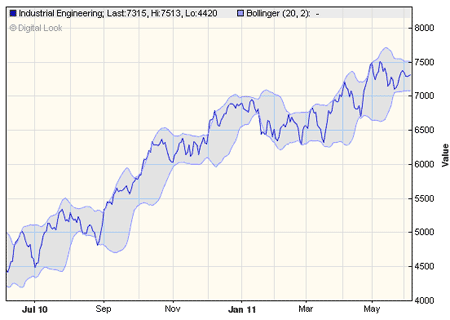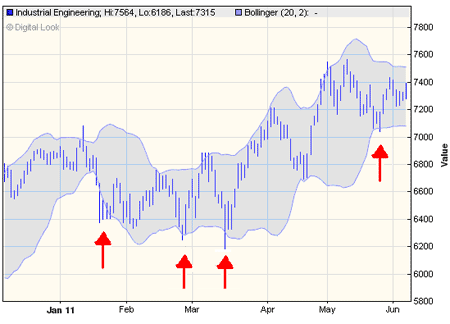The best way to use stop losses
Stop losses are very handy tools for traders. But they can be confusing, and many investors can end up losing more than they gain when using them. Bengt Saelensminde examines why, and explains how to lock in profits by setting stop losses correctly.
Confusion abounds when it comes to stop losses. what's the point of them? Who should use them? And even: What in the hell are they?
Today I shall answer all of those questions, and I'll show you why I think most investors end up losing more than they gain through badly placed stops.
Use this trick to lock in profits and help avert big losses
Put simply, a stop loss is an order that you set in advance to exit a position automatically. It can be a useful tool to get you out of a losing trade without taking too big a loss. Say you buy a stock at £1.00, you could put a stop loss order with your broker to sell it if the price hits 80p.
MoneyWeek
Subscribe to MoneyWeek today and get your first six magazine issues absolutely FREE

Sign up to Money Morning
Don't miss the latest investment and personal finances news, market analysis, plus money-saving tips with our free twice-daily newsletter
Don't miss the latest investment and personal finances news, market analysis, plus money-saving tips with our free twice-daily newsletter
As such it's widely viewed as a kind of Oops, I must have made a mistake; get me out before I lose the lot' type of trade.
But you can also use stops as part of a strategy to lock in profits too. And that's known as a trailing stop loss'. Here, the stop trails the stock's high price as it moves up. Say you buy at £1.00 and you set a trailing stop at 20p below the high; your broker will sell when the price falls 20p from its recent high.
So, if your stock shoots up to £1.70, but then comes off the boil, your broker will sell when it hits £1.50. You lock in a nice profit.
Stops may look good on paper, but you need to tread carefully. Because one of the biggest problems is that investors habitually set them in the wrong places. And with the proliferation of trading accountssuch asspread-bets, which usually demand that you place a stop, I'm convinced many investors end up using stops to lock in losses rather than profits.
Today I want to try to help you set your stops in the right places. Consider these dangers.
Dangerno.1: Setting your stop too tight
By setting your stop too tight, I mean setting it too close to your in-price. If you're only prepared to los say 3% on a stock, then perhaps stock market investing isn't for you. Because such tight stops on most stocks are bound to get hit. And once you're out, you've crystallised a loss and lost your chance to participate in any recovery.
The key here is to set stops at realistic levels. And the way to do that is to take a look at the stock's historic price movement. These days most of the free charting services (let alone anything you're paying for) will allow you to overlay what's known as a Bollinger band' or bolly-bands.
Last week, I recommended placing an up-bet on the industrial engineering sector. Here's its chart and I've included the Bollinger band to help us place the stop.
The industrial engineering sector with Bollinger band

The shaded area showstwo standard deviations from the 20-day moving average of the share price.
The way to think about it is that the shaded area tells us where a share (or index) should trade 95% of the time. And as you can see from the chart, this technical wizardry is pretty good the index trades pretty well inside the band.
The point is you have to set your stop outside of this band.
If your stop is inside the band, it'll likely kick you out of your position even if the stock or index is still in bull territory ie, going up. In this case I'd recommend a stop no higher than 7000, to give a margin of safety. Here's why.
Danger no.2: Rogue prices
Stop loss orders are driven electronically your broker won't be vigilantly hovering over his monitor, watching the prices, ready to pounce.
The price feeds from the exchange go directly to the broker's system. But the problem is that every so often these prices can be erratic especially early morning as markets open. So if the index is trading near the bottom of the Bollinger-band, the price may dip below it.
That price won't even show up on a standard chart. But if I show you the high-low chart (which plots the intra-day highs and lows) you'll see what I mean.
High-low chart with Bollinger bands

With the high-low chart you'll see more clearly that the Bollinger-bands aren't perfect.
I've placed a red arrow at all the points that would have triggered a stop-loss based purely on bolly-bands.
Also bear in mind that the band is based on a 20-day moving average of the price. That means the band is constantly changing, so you may want to go back and re-appraise your stop-levels on a monthly basis.
If monitoring your stop levels seems like too much aggravation, then you should probably consider whether it's worthwhile even placing it.
Dangerno.3: Automatic stops don't give you time to reflect
There are many triggers for sharp corrections in price. And if it's bad news that's hit the stock, you should assess (in a level-headed way) what it really means. I would never advise you to ignore what the market's trying to say. But there are plenty of occasions when the market over-reacts.
You need to assess whether the news will cause ongoing problems for the business, or if it's just a one-off. It may be that all you need to do is re-adjust your stop to take into consideration your stock's new price band.
An automatic stop takes the thinking out of your decision to sell. That's a good thing if it takes emotion out of the decision, but it's seriously bad ifit doesn't give you time to assess the situation.
That's why I generally prefer to monitor my stops manually. Of course, that means I need to be vigilant, and even then, there's a chance I'll miss my moment to sell. But I'd rather sell too late than have to buy back the stock immediately after I've appraised the situation.
BUT beware the old City adage: "Bad news usually comes in threes". If you're going to monitor stops manually, then be sure to assess new information with a level head rather than an emotional heart.
As always, have a plan and stick to it. The most important thing is to set your stops at sensible levels I hope today's issue will help you do that. Just don't go setting stops willy-nilly. If you do, you're bound to come a cropper.
What do you think? How do you use stop losses? Leave a comment below.
This article was first published in the free investment email The Right side. Sign up to The Right Side here.
Important Information
Your capital is at risk when you invest in shares - you can lose some or all of your money, so never risk more than you can afford to lose. Always seek personal advice if you are unsure about the suitability of any investment. Past performance and forecasts are not reliable indicators of future results. Commissions, fees and other charges can reduce returns from investments. Profits from share dealing are a form of income and subject to taxation. Tax treatment depends on individual circumstances and may be subject to change in the future. Please note that there will be no follow up to recommendations in The Right Side.
Managing Editor: Frank Hemsley. The Right Side is issued by MoneyWeek Ltd.
MoneyWeek Ltd is authorised and regulated by the Financial Services Authority. FSA No 509798. https://www.fsa.gov.uk/register/home.do
Get the latest financial news, insights and expert analysis from our award-winning MoneyWeek team, to help you understand what really matters when it comes to your finances.
Bengt graduated from Reading University in 1994 and followed up with a master's degree in business economics.
He started stock market investing at the age of 13, and this eventually led to a job in the City of London in 1995. He started on a bond desk at Cantor Fitzgerald and ended up running a desk at stockbroker's Cazenove.
Bengt left the City in 2000 to start up his own import and beauty products business which he still runs today.
-
 Boost for over 100,000 families on Child Benefit as new HMRC payment system rolled out
Boost for over 100,000 families on Child Benefit as new HMRC payment system rolled outThousands of households will no longer have to pay the dreaded High Income Child Benefit Charge through self-assessment
-
 Are you being haunted by the ghost of Christmas past? How festive cutbacks could boost your long-term wealth
Are you being haunted by the ghost of Christmas past? How festive cutbacks could boost your long-term wealthThe average family spends around £1,000 over the Christmas season. Here’s how much you could have gained if you had invested some of the money instead.